


Newsletter/Nuusbrief 137
February /Februarie 2016 The members’ slot was filled by Franco Cilliers who spoke on Port Elizabeth street names with a First World War connection. He focused on the suburb of Kensington (-33.942688, 25.595655) where five streets are named after either generals or admirals viz. Jan Smuts, Louis Botha, Douglas Haig, John Jellicoe and David Beatty.
The curtain raiser, Under wraps: the story of a top secret British military undertaking in 1915, was presented by John Stevens.
The 1915 deadlock on the Western Front and the enormous casualties which it engendered created a need for a solution to break the stalemate. One of the ideas to emerge in Britain was that of creating an armed self-propelled vehicle that could negotiate, penetrate and destroy enemy defences.To this end the Landships Committee was set up under the auspices of the Admiralty which led to the first viable prototype being developed in September 1915.
Based on broad specifications provided by Colonel Swinton of the Royal Engineers, an artillery tractor was modified and underwent trials heavily disguised and ‘under wraps’. These trials were not successful due largely to problems related to the tracks coming off when suspended over a trench. A new design was then developed, modifying the track system and creating a fish belly shape to the track perimeter to reduce surface area resistance and to improve performance and manoeuvrability. This resulted in a new-look machine in late November of 1915 which was named Little Willie (a tongue-in- cheek mockery of the German Crown Prince Wilhelm, who was known by the nickname of Little Willie in both Britain and Germany).
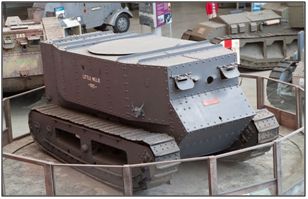
Little Willie
The trials in December solved the problems and Little Willie passed all the tests. As this was achieved however, the specification for the trench crossing width was enlarged beyond Little Willie’s capabilities without a complete and time consuming redesign. A Lieutenant Wilson, a consultant to the Committee had, however, anticipated this requirement with a new design which embodied a Rhomboid shape and enlarged track assemblies. The new prototype based on this design was created early in 1916, tested successfully and became the basis of what we now know as the ‘tank’. Initially given the nickname of Big Willie, it soon however became known as Mother. Mother was fully equipped with weapons and became the basis of the MK1 production tank as implemented by the British Army on the Western Front. Little Willie effectively became redundant as it had achieved its design purpose and played no further part in the war other than for training. FortunatelyLittle Willie survived scrapping attempts after the war which, regrettably, Mother did not, and now occupies pride of place at the Royal Tank Museum in Bovington, England. It remains as the world’s first successful tank design and honours the innovative men who played their part in creating it.
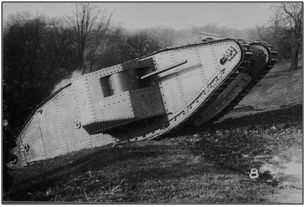
Mother
Hailed by many historians as the most important invention of the war, the tank would eventually help to turn the tide and break the deadlock on the Western Front. It has become a formidable and entrenched part of modern warfare.
The above is a summary of John’s talk. Readers who would like the full transcript, which includes several pictures and statistical data, can contact John directly at j.stevens@ru.ac.za
The main lecture, titled President SamoraMachel’s plane crash revisited, was delivered by Ian Copley. This is a shortened form of the paper which he presented.
"On 20thOctober 1986 I received a Russian patient at No 1 Military Hospital, Pretoria, with a head injury and a fractured femur, who had been transferred from a hospital in Nelspruit. He was confused and claimed to be the pilot of the plane that had crashed on the eastern border of South Africa carrying Mozambican President SamoraMachel. The media knew him as the ‘pilot’, but it was established later that he was the flight engineer who, along with the rest of the crew, was reported by the Russians at the Margo Board of Enquiry as being very capable and ‘experienced’.
On the list of survivors a crew member is named as Vladimir Novosselov, so I take it that that is the name of the flight engineer. I don’t remember the patient’s name whilst in hospital, if I ever knew it. We were given to understand that he had been sitting in the ‘dickie’ seat between the pilot and co-pilot, not strapped in, and was thrown clear on impact. He was the only member of the flight crew to survive – one of nine survivors out of a total of 41 passengers that included two doctors and the ambassadors of Zaire and Zambia as well as deck and cabin crew; figures vary slightly, but most of the casualties were citizens of Mozambique.
My patient improved to full consciousness by the next day. He seemed very lonely as there was no-one to speak to in Russian, so I lent him my tape recorder to play some music to help pass the time. A few days later his blonde wife arrived. After a short while, they both disappeared, together with my tape recorder; presumably they had been transferred back to Maputo. I have not heard that he has ever appeared at any of the three enquiries into the crash. Apparently he was interviewed by the press and gave a survivor’s account. Perhaps the Russians did not regard his testimony as supportive of their ‘decoy beacon’ allegation. I was privileged to hear the voice recorder played twice, once at No 1 Military Hospital and the second time at an International Space and Aviation Congress in Cape Town.
On the morning of 19th October, SamoraMachel’s plane, a twin rear engine jet, the short-haul Tupolov 134A-3, left Maputo and arrived at Lusaka, refuelled and reached Mbala, close to the Tanzania border, at 11h00 for the meeting with Hastings Banda, Kenneth Kaunda and Dos Santos concerning the incursions of Renamo from Malawi into Mozambique. The crew remained in their plane the whole day in the heat waiting to take Machel back to Maputo. They were said to have been drinking beer. The plane, Charlie Nine Alpha Alpha, took off from Mbala at 18h38, for the return to Maputo direct, with an ETA of 21h25 local time, about five minutes later than the actual time of the crash.
The first radio contact with Maputo was at 20h46. The descent from 35 000 feet started at 21h02. They were to report at 3 000 feet. At this level and 113 km from the destination the captain, according to the flight engineer, switched off the autopilot. The plane would have been homing in on the Maputo VOR and was still on track; for some reason he had taken over manual control. From the voice recorder it would seem that ‘the crew were more concerned with finishing the flight than with following standard aviation procedures and cross checks. The captain was busy arranging drinks with his flight engineer’ – three beers and one coke.
At 21h10 the navigator, the only crew member able to speak any English with which to communicate with the Maputo Air Traffic Control, informed the captain that a 37° turn to the right was required. When he queried this the navigator answered ‘VOR indicates that way’, which he then accepted. [The VOR frequency for Maputo [MA] is 112.7 whereas that for Matsapa [MS] in Swaziland is 112.3. It would seem that the navigator had made an error of .3 for .7 having misread Matsapa for Maputo frequency]. The wrong Morse Code S (· · ·) for A(· -)seems less likely.
They were then on a heading for the mountainous eastern escarpment, the Lobombo Mountain chain along the South Africa, Mozambique and Swaziland border. They were still in radio contact with Maputo and during the last five minutes of the flight were concerned about whether the runway lights were on or not at Maputo airport as they could not see any city lights or runway lights. Was there a power cut at the time in Maputo? There was much confusion with the air traffic controller – a Russian radio operator speaking English to a Mozambican traffic controller who, I was told, had recently failed the English exam. It was a moonless night with no thunderstorm activity and there were no lights to be seen anywhere. They were expecting to be over the sea or low-lying coast on this new heading and continued their descent. Although the weather was good, they queried clouds obscuring lights on the ground (officially reported as 3/8 cover). At 21h21 the terrain proximity warning sounded, but was ignored. On the voice recorder the captain’s increased breathing rate can be heard as his options diminish. Thirty seconds later the voice recorder was silent.
It is of interest that the Tupolov website registers many crashes around the world for this model of airliner that went out of production in 1980. The entry for 1986, South Africa, the cause of the crash is given as a ‘thunderstorm and failure of the terrain proximity warning’. There was no thunderstorm; the terrain proximity warning was working; it was rather that the crew took no notice of it. In my view, apart from poor flying procedure and the incompetence of the air traffic controller in Maputo, the captain is to blame since if he had not disconnected the auto pilot, he would still have been locked onto the Maputo VOR and the navigator would not have selected an erroneous Matsapa beacon(MS) instead of that of Maputo(MA). It was reported that the navigation equipment was not of a very high quality; the backlighting of the dial was very poor.
Having flown from Lusaka to Mbala and then directly for Maputo the aircraft was approaching its maximum range of 2770 km and was low on fuel, although the payload of personnel was relatively small. There was insufficient fuel for an alternative destination such as Beira, or anywhere other than in South Africa. In any case, at the nearest airfield, Matsapa in Swaziland, the tower was closed at that time of night. (I was told that the policy of Russian aircraft landing at Maputo with a large excess fuel was to be avoided as it tended to be syphoned off for sale in the local black market.)
When the Maputo traffic controller lost contact with the aircraft he informed the authorities that the plane was four minutes overdue.The crash site was near to the village of Mbuzini south of Komatipoort, just inside the South African border with Mozambique.It was reported that a survivor went to a nearby mission to ask for help. Pik Botha, South African Foreign Minister, was telephoned about the crash at 04h30. He then informed the Prime Minister, PW Botha, and was asked to visit the crash site himself. The police arrived at 02h00 from Komatipoort and presumably at some time confirmed the identity of the most important passenger among the dead, perhaps through the papers scattered about. The crash site would have been difficult to locate in the dark as there was no fire and there was difficulty of access to the area. The many injured were evacuated by helicopters and arrived at a hospital in Nelspruit at 08h00. There would have been sufficient daylight to fly there before 06h00. (Sunrise on that date was 05h18 local time). However, it was said that “helicopters arrived at Mbuzini at 04h00.”
In conclusion, Ian listed some of the accusations levelled against South Africa, mainly by the then USSR and Mozambique. These focused on claims of deliberate sabotage, the intention to murder Machel, and to destabilize Mozambique. South African responses to these were also listed pointing to the international nature of the Margo Board of Enquiry which concluded that the primary cause was deviation from the course due to pilot error, for which evidence was provided. Despite rumours to the contrary there was also nothing to be gained by South Africa from the incident.
In the nearby Mbuzini village there is now a monument to Machel and a museum.
An article on the monument and museum at the crash site has been published in The Heritage Portal Newsletter #1/2016. It can be found at
http://www.theheritageportal.co.za/article/air-crash-monument-must
Future meetings and field trips/ Toekomstige byeenkoms en uitstappe
The next meeting will be on Monday 8th February 2016 at 19h30 at the Eastern Cape Veteran Car Club in Conyngham Road, Port Elizabeth. The curtain raiser will be by Leticia Jacobs on the subject SAWAS. The main lecture titled Rorke’s Drift will be by Tiaan Jacobs.
Matters of general interest / Sake van algemene belang
New member/ Nuwe lid
We welcome Michael Newcombe as a member of the South African Military History Society. We hope he will enjoy a happy association with the East Cape Branch and look forward forward to having him join us at meetings and field trips.
Errata
Fred Nel, noting that there were a couple of anomalies in his presentation in Newsletter 136, has requested that the following points be clarified.
Pat Irwin delivered the opening address of the First World War exhibition at the Albany Museum in Grahamstown in December. The exhibition will last until 2018.
Parades and commemorations
The Dalton’s Grave Memorial Service will take place at the Russel Road Cemetery, Port Elizabeth, at 10h30 on Sunday 24th January 2016. All are welcome to attend.
The Three Ships Commemoration Service will take place at 11h00 on 21st February at St. Paul's Church, Tucker Street, Parson's Hill, Port Elizabeth.The Service remembers those gallant men who died in the tragedies of the SS Mendi in February 1917, HMSAS Southern Flow in February 1941 and the SAS President Kruger in February 1982. All are welcome to attend.
100th anniversary of the loss of HMS Natal
The 30th December 2015 marked the sinking, due to an internal explosion, of HMS Natal, a ‘Warrior Class’ (aka ‘Duke of Edinburgh Class’) cruiser of 13 550 tons. The connection to the province of Natal was not only in the name: the inhabitants of the then Colony had in fact paid for the ship’s construction, which cost the princely sum of £ 1 218 244 – a not inconsiderable amount for a relatively small colony.
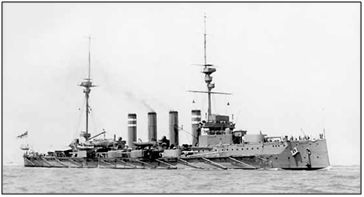
HMS Natal 1905-1915
Built by Vickers, Sons and Maxim, she was launched at Barrow-in-Furness on 30th September 1905 by the Duchess of Devonshire. Natal’s main armament consisted of six BL 9.2-inch Mark X guns (i.e. similar to those later installed on Robben Island and around the Cape Peninsula) making her a powerful addition to the Royal Navy fleet of the time.
Among the official guests on the launch podium were Sir William Arbuckle, Agent-General for the Colony. At the post-launch luncheon Sir William read a cablegram from the Prime Minister of Natal, Mr Charles John Smythe, (whose grandson Sgt. Quentin Smythe was one of the South African recipients of the Victoria Cross during the Second World War) wishing all good fortune to the ship, while the Duke of Devonshire, whose wife had launched the ship, delivered a speech in which he noted that “It was a happy inspiration to give the ship the name of one of our colonies … and on behalf of the Duchess and myself, I wish the Natal a long, successful and glorious career.” The inhabitants of Natal maintained a lively interest in the career and movements of the cruiser as well as in the sailors who manned the warship. When the First World War broke out they had silver medals struck, which were awarded to the crew.
In addition to her regular pre-war duties such as patrolling the North Sea, she was the principal escort when the newly-crowned King George V and Queen Mary visited India in 1911-12. The Natal also had the duty of carrying the body of the U.S. Ambassador to Great Britain, back to New York in December 1912 – a voyage noted for its extremely stormy crossing. After completing this mission, her crew gave her the nickname of ‘Sea Hearse’.
With the outbreak of war in 1914 HMS Natal joined the Second Cruiser Squadron, which by 1915 was based at Cromarty Firth in the north of Scotland. As part of the Christmas festivities on the afternoon of 30th December 1915, the Natal’s captain, Eric Black, hosted a film show for officers and their visiting families including children. Nurses from the nearby hospital ship Drina were also invited. Not many were able to accept the invitation: nevertheless seven women, one civilian male, and three children came on board for the occasion. Just as the party was getting under way a series of massive explosions tore the ship apart and she sank in a matter of minutes.
It came as a shock to Natalians to hear of the disaster that had befallen ‘their’ cruiser and the 421 souls who perished in her. It is unclear how many, if any, South Africans were serving on board at the time and it has thus far not been possible to determine whether there were any South Africans among the survivors or the casualties, although some reports suggest that a number of South Africans were lost.
A memorial to the ship was erected by public subscription at the Old Fort in Durban in 1927 and there are individual memorial plaques in a number of British churches. It is not known if there are any in South African churches. A garden called Natal Gardens was opened in 2000, at Invergordon near Cromarty Firth, which contains a commemorative plaque remembering Natal. HMS Natal was one of five Royal Navy ships destroyed by internal explosions during the First World War.
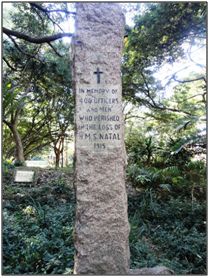
The monument to HMS Natal
at the Old Fort in Durban
World War I Centenary Year / Eerste Wêreldoorlog Eeufeesjaar
The Road to the Somme
John Stevens will be presenting an extended lecture on The First Day of the Somme at the July meeting this year. As a build-up to it and to enhance understanding of the ‘First Day’ and of the five-month long battle itself, John will be giving a brief account of key events leading to it in the Newsletter over the next five months ending in June.
"When the British Government declared war in September 1914 it faced a major dilemma. The British Standing Army (six infantry divisions) was tiny in comparison to the huge conscript-based armies of the major powers of continental Europe. While a well-trained, well equipped and experienced professional force, largely unchanged in size and organisation to the specifications laid out by the Duke of Wellington late in the Napoleonic Wars a hundred years earlier, it would not be able to match the shear strength of Germany and its allies or be able to play a major role in supporting, France, Belgium, and Russia. The British Army’s main strength consisted of the British Expeditionary Force (BEF), primarily a reaction force held ready to be deployed at short notice anywhere in the Empire. This would need to change if Great Britain was to play its part as a major world power and the army would urgently need massive upsizing. Conscription had never been entertained before as Britain had always relied on volunteers to swell its army’s ranks in time of need. Enlarging the army to the required proportions would be a major challenge to which a solution would have to be found ... and would have a direct and profound impact at the Somme two years later." Major engagements inFebruary 1916
The Battle of Verdun took place between 21st February and 18th December 1916. The German siege and attacks on Verdun and its ring of forts constituted the longest single battle of the First World War.
Believing that Britain formed the foundation of the Allied effort ranged against Germany and that to have any chance of victory she must be removed from the war, the Germans decided to implement a policy of unrestricted submarine warfare against merchant shipping. This was aimed at starving Britain into submission in much the same way as the British Naval blockade of the North Sea aimed to do to Germany. Combined with a knock-out blow to France this would, the Germans believed, bring about a successful conclusion to hostilities.
It was hoped to achieve this by a set-piece siege and concentrated attack the town of Verdun, and in so doing, draw in and divert French troops from all over the Western Front to the eight mile wide front around Verdun. The plan was to subject Verdun to intense bombardment. Falkenhayn, the German Chief of Staff’s stated aim was to ‘bleed France white’ in its defence of the ancient fortress town, which to the French had more symbolic than strategic value. In so doing the Germans effectively switched the focus from the Eastern Front to the Western Front. The staunch French defence of the town and the capture and recapture of the surrounding forts over the next 10 months had led to a non-conclusive stalemate when the Germans discontinued the battle on 18th December.
French casualties during the battle were estimated at 550 000 with German losses set at 434 000 – men which she could ill afford to lose. The only real effect of the battle was the irrevocable wounding of both armies: no tactical or strategic advantage had been gained by either side.
An interesting naval action modestly called the Action of 29th February took place in the North Sea between a German commerce raider SMS Greif and four Royal Navy warships; the auxiliary cruisers HMS Alcantara and HMS Andes, supported by the light cruiser HMS Comus and the destroyer HMS Munster which arrived only at the end of the action. Much of the action was a close range duel between the Greif and Alcantara, both of which were sunk. An estimated 187 Germans perished along with 72 Britons. 125 Germans were rescued by Andes and Munster.
Websites of interest / Webwerwe van belang
Obituary:
Lieutenant-Commander David Balme, leader of the boarding party from HMS Bulldog, which recovered the Enigma machine from U-110 in 1941 The Telegraph 3rd January 2016
http://www.telegraph.co.uk/news/obituaries/12078997/Lieutenant-Commander-David-Balme-obituary.html
Major General Richard Clifford – Royal Marines officer who parachuted into the sea with Special Forces to deal with a bomb scare on the QE2
The Telegraph 29th November 2015
http://www.telegraph.co.uk/news/obituaries/12023381/Major-Richard-Clifford-obituary.html
World War I
HMS Audacious: The only super-Dreadnought sunk in WWI – by a German naval mine
War History Online 22nd December 2015
https://www.warhistoryonline.com/featured/hms-audacious-dreadnaught-sunk.html
World War II
Japanese Army atrocities: the case of Korean comfort women
Dennis J Bernstein Reader Supported News 7th January 2016
http://readersupportednews.org/opinion2/277-75/34480-focus-88-year-old-survivor-of-japanese-sex-slave-camp-rejects-agreement-with-japan
Building Hitler’s supergun: the plot to destroy London and why it failed
Hugh Grant IFL SCIENCE 23rd November 2015
http://www.iflscience.com/technology/building-hitler-s-supergun-plot-destroy-london-and-why-it-failed
Cold War and post Cold War
Gary Powers: The U2 spy pilot the US did not love
Jason Caffrey BBC World Service 3rd January 2016
http://www.bbc.com/news/magazine-35064221
‘The man who saved the world’ – The Russian who prevented WWIII
War History Online 24th December 2015
https://en.wikipedia.org/wiki/1983_Soviet_nuclear_false_alarm_incident
In underwater battle, India 'annihilates' American nuclear submarine
Jugal R Purohit India Today 28th November 2015
http://indiatoday.intoday.in/story/in-underwater-battle-india-annihilates-american-n-submarine/1/533506.html
French submarine 'sinks' entire US aircraft carrier group during wargames
Sputnik News 6th March 2015
http://sputniknews.com/news/20150306/1019130173.html#ixzz3wNSxCuIy
US Navy's first Zumwalt-class (Stealth) destroyer begins sea trials
David Szondy Gizmag 9th December 2015
http://www.gizmag.com/navy-zumwalt-destroyer-sea-trials/40818/
Russian& Soviet Fleets, 25 Years Apart
Louis Martin Vezian CIMSEC 28th November 2015
http://cimsec.org/russian-soviet-fleets-25-years-apart/20218
Weapon security: missing U.S. Hellfire missile shows up in Cuba
Devlin Barrett & Gordon Lubold Wall Street Journal 7th January 2016
http://www.wsj.com/articles/missing-u-s-missile-shows-up-in-cuba-1452213667
Falklands War
Untold story of RoyalMarines’ heroism on the eve of the Falklands War
War History Online 3rd January2016
https://www.warhistoryonline.com/war-articles/untold-story-british-marines-heroism-eve-falklandswar.html
Historic aircraft
Some World War II aircraft: The Focke-Wulf Fw 190 and four more (Me Bf 109; Heinkel He 162; Spitfire and Ju 87 Stuka)
About.com Military History 22nd May 2015
http://militaryhistory.about.com/od/worldwariiaircraft/p/focke-wulf-fw-190.htm?utm_content=20160104&utm_medium
=email&utm_source=exp_nl&utm_campaign=list_militaryhistory&utm_term=list_militaryhistory
Birth of the B-29
War History Online 4th January 2016
https://www.warhistoryonline.com/military-vehicle-news/watch-birth-of-the-b-29.html?utm_source=getresponse&utm_medium=email&utm_campaign=warhistoryonline&utm_content=[War+History+Online]+Your+Daily+Dose
Flying the B-52: Classics with character
Edmund Fountain and Jessica Naudziunas U.S. and Politics 6th December 2015
http://www.nytimes.com/video/us/100000004027558/flying-the-b-52-classics-with-character.html?em_pos=small&emc=edit_fs_20151208&nl=video&nlid=59439727
Resource materials of military historical interest/
Bronmaterieel van krygsgeskiedkundige belang
* Richard Tomlinson informs us that Tony Westby-Nunn has two photocopies of Colin Coetzee’s Forts of the Eastern Cape at a cost of R700.00 each. Anyone interested in further details can contact Richard at richardtomlinson400@gmail.com or 041 581 2108 / 083 558 2277.
* A world map of disputed territories http://metrocosm.com/disputed-territories-map.html?1448460590077=1
* Members’ attention is drawn to the The Van Riebeeck Society for the Publication of Southern African Historical Documents. Many of these publications are of direct interest to military historians and a complete list of the 96 volumes published to date can be found at http://www.vanriebeecksociety.co.za/publcats.htm and at http://www.vanriebeecksociety.co.za/catalogue.htm. Without exception these documents are of high literary quality.
Members are invited to send in to the scribes, short reviews of, or comments on, books, DVDs or any other interesting resources they have come across, as well as news on individual member’s activities. In this Newsletter, there have been contributions by Richard Tomlinson, Malcolm Kinghorn, Barry Irwin, Michael Irwin, Peter Duffel-Canham and John Stevens.
Chairman: Malcolm Kinghorn: culturev@lantic.net
Secretary: Franco Cilliers: Cilliers.franco@gmail.com
Scribes (Newsletter): Anne and Pat Irwin: p.irwin@ru.ac.za
TAILPIECE:
A reflection on the 70th anniversary of the liberation of the Dutch city of Arnhem and its Grahamstown connections After the debacle of Operation Market Garden in September 1944, Arnhem was finally liberated from the Nazis on 13th April 1945. One of the units most heavily involved was the Staffordshire Regiment, a direct descendent of the 38th Regiment of Foot (the South Staffordshire Regt) who defended Grahamstown during Makana’s attack on the town in 1819 and in doing so, determined the future course of South African history. The Regiment was raised in 1705 and has fought on all continents and in most of Britain’s wars since then. During the First World War, it fielded 35 Battalions and won seven Victoria crosses. The Second World War saw 17 Battalions and three Victoria Crosses, two of them at Arnhem. Arnhem is first mentioned in literature in 893, but is known to have been inhabited as early as 1500 BC. Because of its pivotal geographical position, it has been estimated that over 50 armies and possibly many more have passed through the town, with varied intent, over the period of its existence.
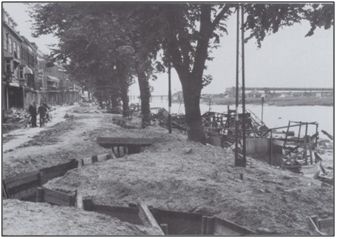
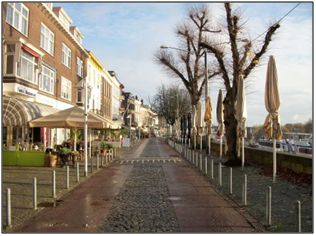
Then and now: the banks of the Rhine in 1944 and the same view today. The trenches were dug by the defending Germans.